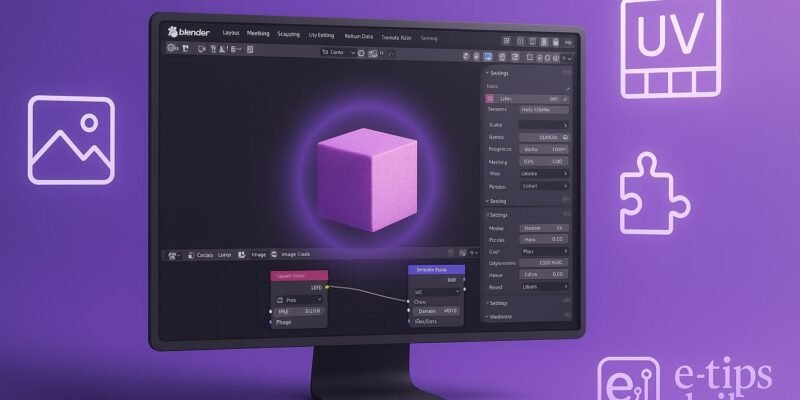When your textures won’t render in Blender, it can grind your project to a halt. Whether you’re working on a character, environment, or animation, missing textures can break the realism and final output.
In this guide, you’ll learn exactly how to troubleshoot and fix texture issues in Blender—step by step. We’ll cover everything from viewport settings to UV maps and render engines. By the end, your textures will display as they should, and you’ll know how to prevent this problem in future projects.
Let’s fix it once and for all.
Step-by-Step Guide to Fix Blender Not Rendering Textures
- Switch to the Right Viewport Shading Mode
- In the top-right corner of the 3D Viewport, click the Viewport Shading button and select Material Previewor Rendered.
- Why it matters: Texture display doesn’t show in Solid mode by default.
- Confirm You’re Using the Correct Render Engine
- Go to Render Properties (camera icon) → Check Render Engine (Cycles or Eevee).
- If you’re using Workbench, textures won’t render. Switch to Cycles or Eevee.
- Make Sure Materials Have an Image Texture Node
- Go to the Shader Editor.
- Check if your material has an Image Texture node connected to the Base Color of the Principled BSDFnode.
- If not, add it using Shift + A → Texture → Image Texture, and connect it properly.
- Verify the Image Texture Is Loaded
- On the Image Texture node, make sure an image file is actually selected and not empty.
- Click the folder icon to load the correct texture if needed.
- Check UV Mapping
- Select your object → switch to UV Editing workspace.
- Ensure the object has UVs and the image is mapped correctly.
- If UVs are missing, use U → Smart UV Project or manually unwrap.
- Apply All Transforms
- Press Ctrl + A → Apply All Transforms on your object.
- Prevents scale and rotation issues that might affect texture mapping.
- Ensure “Use Nodes” Is Enabled
- In the Material Properties, confirm Use Nodes is active for your material.
- Review Material Assignments
- Select the object → go to Material Properties.
- Confirm the correct material is assigned and that it includes the texture.
- Pack External Files
- Go to File → External Data → Pack Resources.
- Prevents Blender from losing file references, especially when moving projects.
- Check for Cycles GPU Settings
- If using Cycles, go to Preferences → System.
- Ensure GPU is selected correctly under CUDA, OptiX, or Metal for better rendering performance.
Pro Tips & Workflow Improvements
- Use Node Wrangler Add-on
Activate it under Edit → Preferences → Add-ons → Node Wrangler. It makes linking textures and materials much faster with shortcuts like Ctrl + Shift + Click. - Use Material Preview with Lighting
Sometimes textures appear dark—toggle Scene Lights and Scene World in the top-right shading options. - Bake Textures for Complex Materials
If using procedural textures or complex shaders, bake them into images to ensure proper rendering. - Save Your .blend File Before Packing Resources
This ensures any links or paths are preserved before embedding assets. - Use Relative Paths for Portability
Go to File → External Data → Make All Paths Relative. This prevents broken links when sharing projects.
Advanced Use Case: Diagnosing Transparent Textures Not Showing
If your transparent textures (like PNGs) aren’t rendering properly:
- In the Shader Editor, connect Image Texture → Alpha to Principled BSDF → Alpha.
- Set Blend Mode to Alpha Blend in the Material Properties → Settings.
- Enable Show Backface and tweak Shadow Mode for realism.
This is especially useful for leaves, decals, or character hair.
Troubleshooting & Common Mistakes
- Texture appears pink?
- Blender can’t find the image file. Re-link it via the Image Texture node or use File → External Data → Find Missing Files.
- Texture not visible in final render?
- Ensure UVs, Material assignment, and Render Engine are correctly set.
- Materials disappear after moving the file?
- Use Pack Resources or set paths to relative before moving project folders.
- Wrong mapping scale or orientation?
- Check the Mapping Node or UV scale and apply transformations.
- Object renders gray or default?
- Double-check that the material is actually applied to the object.
Conclusion
Blender texture issues can be frustrating, but with the steps above, you now know how to systematically fix missing or broken textures—whether it’s a viewport issue or a material setup problem.
Practice on a few test objects, then apply these checks to your real projects. For your next step, try exploring PBR texture workflows or texture painting in Blender to level up your skills.

